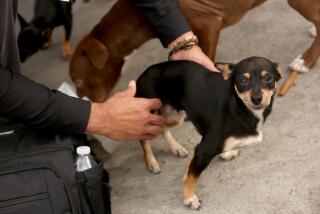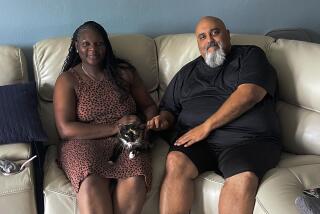Tuning in the Pooch : Lifestyle: Microchips implanted in animals are helping reunite owners with their lost pets. The technology may replace typical dog tags and is being used by many animal shelters.
It’s not exactly radar for pets, but it’s close.
Orange County veterinarians and animal shelters are now implanting microchips that experts say will someday replace the dog tag or collar.
The microchip, the size of a grain of rice, is injected between the shoulder blades of an animal and emits a harmless radio signal.
Orange County Animal Control Sgt. Marie Hulett-Curtner says the process is painless, but adds: “The ones who cry are the big babies, like Rottweilers and German shepherds.”
Dogs are not the only animals that can receive such a device.
“Anything that walks, talks or flies,” says Dr. Dick Evans of Orange County Animal Control.
If a lost animal is recovered by a shelter, attendants can scan for the chip using a hand-held device resembling a futuristic iron. If found, the scanner will produce an identification number registered with the microchip company. After contacting the microchip company, the veterinarian is called, who in turn alerts the owner. The chip and registry costs about $70.
“It’s just an outstanding life insurance policy for your pet,” says Hulett-Curtner. Using microchips beats other methods of pet identification, says Dr. John Hamil of the Laguna Beach Animal Shelter. Tags can get lost and tattoos, frequently placed under the hind leg, can be hard to get to--especially if the stray doesn’t want to be checked, Hamil said.
Veterinarians say uses of the chip can range from monitoring laboratory and wildlife species to recording results of competitive events, such as dog shows or horse races, to simply proving ownership in legal disputes. “When you pay $3,000 for a macaw, you might want to know if it’s yours,” Hamil says.
“It’s for the benefit of the pet owner,” said Carl Pagano, superintendent of Irvine Animal Services. “We treat it almost like a pet license.”
Pagano said they receive between one and six animals daily, and each one is scanned for a chip. They went on-line last August, but have yet to come across a chip.
Others are having more success.
Hulett-Curtner said her facility has been finding a chip a week. In one case, “we called the owner before he even knew the dog was gone,” said Hulett-Curtner. “He was just thrilled to death.”
While the system sounds foolproof, its strength lies in how many shelters scan for such a chip, says Hamil, who is also president of the California Veterinary Medical Assn. Three chips are on the market, so some animal associations are waiting for one to gain popularity.
“The industry does not seem to have shaken itself out yet,” said John Mandeville, American Kennel Club vice president. With more than 10,000 events under AKC jurisdiction, Mandeville said he is eager for the AKC to promote a chip, but he is cautious about selecting one this early in its development.
Hamil’s facility, like most other Orange County animal shelters, uses a chip produced by a company called Avid. Another chip, Trovan, a newer and the most advanced chip on the market, is used in Ventura County.
“We’ve taken a very aggressive position on standardization,” says Hannis Stoddard III, founder and president of Avid.
While standardization of scanners and chips has not been achieved, “the real reward is finding somebody’s animal,” he says. “That’s a real rush.”
More to Read
Sign up for Essential California
The most important California stories and recommendations in your inbox every morning.
You may occasionally receive promotional content from the Los Angeles Times.










